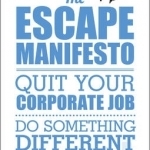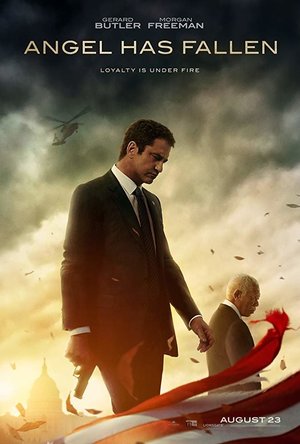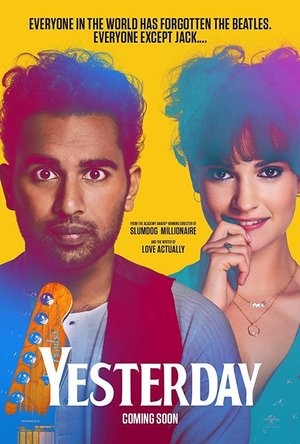James P. Sumner (65 KP) rated Angel Has Fallen (2019) in Movies
Aug 21, 2019
We see an aging and sore Banning, struggling with the rigors of his profession, torn between his love for his duty to protect the President and the smart, semi-retirement position as Secret Service Director.
This takes a little while to get going compared to most films in the genre, but it isn't too long before everything goes sideways and Banning finds himself on the run from everyone, framed for something we all know he didn't do. The question is: who did it?
Drawing obvious inspiration from classic genre entries like Die Hard, as well as more modern offerings like John Wick, Gerard Butler takes on everyone from both sides of the law as he tries to get to the bottom of the conspiracy.
Aside from the slightly slow start, the pacing of this film is spot-on, mixing balls-to-the-wall action with gripping tension - accompanied by a very clever soundtrack that enhances the experience well.
The dialogue feels real and meaningful. There's nothing cheesy, no scene-filling conversations or anything, which is always a genuine concern with this type of film. Everything is done with a purpose.
I think perhaps too much effort was made to make this a 15-certificate (an R-rating for you lovely Americans). It was more for the language than anything. The violence and fighting was well-choreographed, taking the up-close, gritty approach akin to the Bourne movies, but there was nothing here that wouldn't have made the cut for a 12A. I think they gambled with the post-Deadpool debate of having a wider audience for a 12A vs. the "it's a 15, therefore it must be good because kids aren't allowed" appeal. I'm not saying it ruins the movie, I just think it was unnecessary. The aforementioned Deadpool, for example, absolutely wouldn't have worked if it was less than a 15, so I get why they made it the way the did. But with this, it would've been the exact same film either way, so why cut out a sizable portion of cinema-goers?
That being said, I did really, really enjoy this film. Is it predictable? Sadly, yes. That probably isn't THAT shocking of a revelation, as these types of films tend to follow a similar (and usually winning) formula, but I confess to being a little disappointed that I was able to figure out the main antagonist and the overall "big bad" within three minutes of the film starting. However, to this film's credit, this predictability doesn't take away from the experience at all. It's quite honest about what it is from the get-go, and it simply doesn't care. It does what it sets out to do, and it does it very well - better than a lot of similar movies in recent times. As with all films in this genre, people tend to watch them knowing what they're getting themselves in for, so you can just relax, switch off, and enjoy the ride for a couple of hours.
I can't sign off without mentioning Nick Nolte's turn as Butler's father. His performance, while not surprising, feels almost out-of-place, as it's so damn good he deserves an Oscar nod. He probably won't get one, as films like this tend not to get noticed by the Academy, but let me tell you, he steals every scene he's in, and you feel every word he says. There's an obvious comparison to the character he portrayed in Warrior, alongside Tom Hardy and Joel Edgerton. While he gets nowhere near as much screen time here, he makes the most of what he does get, and it truly is the stand-out performance of the year so far, by a long way.
This film is a solid 7/10, and I highly recommend it. I bumped it to an 8/10 because of Nick Nolte. If I could go back and just watch his scenes again, I would. Grab the popcorn, forget about the outside world... you could do a lot worse at the cinema right now than this.

Prayer Prompter - Christian Prayer App
Productivity and Lifestyle
App
A God-centered, worship-based prayer app that stores and organizes Scripture passages and prayer...

Simple Home Health Exercises: Easy fitness workout
Health & Fitness and Photo & Video
App
Home exercises will give you simple and easy fitness workouts videos which you can try at home. We...

Fit Men Cook - Healthy Recipes
Food & Drink and Health & Fitness
App
Struggle free, healthy and practical recipes that are easy on the wallet. It’s as simple as that,...
Purple Phoenix Games (2266 KP) rated Exodus: An Interstellar Pathways Adventure in Tabletop Games
Jan 10, 2022
Exodus is a “choose thine own pathway” card game for one to five players. In it, players will be reading sections of a story that unfolds across several oversized cards in the hopes of settling down on some other planet not being torn apart by galactic war. Sound familiar?
DISCLAIMER: We were provided a copy of this game for the purposes of this review. These are preview copy components (I think), and I do not know for sure if the final components will be any different from these shown. Also, it is not my intention to detail every rule in the game, as there are just too many. You are invited to download the rulebook or purchase the game from the publisher directly. -T
Setup is super simple with this one. Yank out the cards from the box (and make sure they are numerically ordered), place them in a stack on the table, and also place out the stack of Inventory cards. The main Exodus cards are numbered 1-121 and there are 12 Inventory cards. Determine the first reader and the game may begin!
There really are not any “rules,” aside from reading the new card/scenario and choosing the card to jump to in order to continue the story. Or die, as I happen to do quite often. DARN YOU, CARD 13!! Players may decide to follow one path, or players may even split up and follow their own stories. The rules state that stories may have players rejoining each other on future cards, but I have yet to experience that before death.
The game continues with players reading cards, collecting Inventory items that are necessary for certain future choices, and attempting to tell a great story. Exodus could take five minutes, or even up to 60 minutes if the players make good choices. Players decide when to finish, and are even allowed to respawn after death or even retrace their steps in order to choose alternate endings to their stories.
Components. Again, we were provided with a prototype copy of the game. That said, Exodus is a box full of big tarot cards depicting excellent artwork and lots of text to be read. This certainly is not a game for budding readers (like my 5-year-old), but for players who enjoy a nice night reading an interesting sci-fi story.
I have a hard time deciding if I consider this a game or not. There are definitely choices to be made, akin to those made in the inspiration sourcebooks. However, I really feel this is more an activity that is set in the Xenohunters universe that may setup lore and be a jump-off to other games in the family. This is not at all a knock on the game, as having fleshed out lore for a game universe is necessary for a series containing several titles. You know, a game or not a game, I enjoyed playing through this one and discovering little secrets about the lore of the Xenohunters universe.
Though this isn’t a complex game at all, the choices made are sometimes quite difficult and could result in game-end conditions. I have definitely had games last five minutes before I died, but I have also had a couple that have lasted a lot longer as I try to find optimal choices and even backtracked a choice or two. I think I would suggest gamers play through this one a few times before attempting the Xenohunters game, if just for the backstories and lore alone. Want to grab a copy for yourself? Check out the Half-Monster Games store listing for Exodus. I also recommend grabbing both Xenohunters and Trust Me, I’m A Superhero. They are both great!
Heather Cranmer (2721 KP) rated The Little Teashop on Main in Books
May 6, 2019
The plot for The Little Teashop on Main was done brilliantly! Jodi Thomas has written a beautiful story that really sucks you in and makes you feel every single written word. Zoe, Shannon, and Emily meet for a tea party whenever they can starting from when they were little. As the story progresses, the reader gets to watch each of the girls grow into strong women. The reader gets to grow up with all of the girls through all of the ups and downs of life. Each chapter in the book is focused on a certain character so the reader gets to gain that character's perspective on things. While there are similar story lines to The Little Teashop on Main, Jodi Thomas does such an excellent job of making this one feel unique. I felt like I was instantly transported to the small town of Laurel Springs whenever I was reading The Little Teashop on Main. While there weren't any major plot twists, I felt as if this was the type of book that doesn't need to rely on plot twists to keep it interesting. The emotional pull is all it needs. I loved how there were no cliffhangers and all of my questions were answered by the end of the book.
The characters in The Little Teashop on Main were so well written and such a delight to read about! I loved every one of them. Usually I have a favorite, but I would hate to be forced to choose just one favorite. I loved Zoe's zest for life. Her larger than life presence was such a joy to read about. I would have loved to have a friendship like Zoe's and Jack's. Shannon had such a great work ethic that was admirable. Just how focused she was was an inspiration. I kept on wanting things between her and Jack to work out. I don't think I've ever wanted to a couple to be together more than Jack and Shannon. Shannon was such a planner and so focused. Sometimes I wanted to just grab her by the shoulders until she realized how great she'd be with Jack! I just wanted to hug Emily. She had struggled with depression for so long. I could relate to her the most. Emily was such a sweet girl that blossomed into a sweet woman. I was always cheering Emily on when I would read about her. I loved how much Jack cared about all three girls and how much he loved them all. He was such a loyal friend. I'm glad I got to read and get to know Fuller. What a sweet boy/man he turned out to be! Alex and Mack were also great characters and great parents. The love for their daughters was so obvious. The way the townspeople of Laurel Springs came together was so heartwarming to read about.
I will admit that the first 45 percent or so of The Little Teashop on Main was a little slow. I did wonder if I had made a mistake with this book. However, I'm glad I persevered. The pacing quickly picked up after that, and I could not put this novel down. I hungered for more, yet I would become sad because I realized that this story would be over soon. When I did finish The Little Teashop on Main, I was disappointed only because I wished it didn't have to end!
Trigger warnings for The Little Teashop on Main include depression, suicide attempts, cancer, a car accident (wounds aren't described too graphically), and sex (although not graphic).
All in all, The Little Teashop on Main is such a heartwarming read. This book makes you feel as if you are one of the characters. It is written so beautifully, and I can't gush enough about how great it is! I would definitely recommend The Little Teashop on Main by Jodi Thomas to those aged 16+. This book gets a 4.5 out of 5 stars from me.
--
(Thanks to HQN for providing me with a paperback of The Little Teashop on Main by Jodi Thomas in exchange for an honest and unbiased review.)
Darren (1599 KP) rated Amadeus (1984) in Movies
Jun 20, 2019
We see how Mozart constantly ends up out shinning Salieri with his music leading to the rivalry between the two, with Salieri serious look on life and Mozart’s flamboyant style of just getting through each moment. Salieri moves into the position of being the connection to the Emperor to get his unique work out there but he is really just building him up for failure trying to break him down with criticize of his work.
REPORT THIS AD
Amadeus gives us a brilliant look at one of the greatest musical minds in the history of man. We know the basic idea of what happened to him but now we get to see it through the eyes of one of his closest friends even if he is filled with envy for him. What starts as envy is filled with respect and seeing how a talented person can get used by all the people close to him which will drive him into his bad ways. Overall this really is a brilliant drama that is told in a way we can just enjoy.
Actor Review
F Murray Abraham: Antonio Salieri admits that he killed Mozart, but now he is confessing to how he believes he was responsible for the death from inside an insane asylum. We watch how he got his dreams of working with music and constantly found himself lacking the complete flair and natural ability of Mozart leading to jealous and planning to bring him down slowly. F Murray gives us a brilliant and well deserved Oscar winning performance in this role.seleir
Tom Hulce: Wolfgang Amadeus Mozart is the flamboyant and brilliant composer who lives life on the edge spending every penny he ever received for his work, he pushes the boundaries to what is accepted even if his work is loved. He gains inspiration from his personal stories which will gain him enemies from his own confident in the government. Tom gives a performance that could easily have won him an Oscar too.morzart
Elizabeth Berridge: Constanze Mozart is the wife of Wolfgang, she supports him in all the work he does but just wants him to actually get paid for the work so they can look after the family, even after she lives him she feels guilty. Elizabeth does a good job in this role.
Roy Dotrice: Leopold Mozart is the overbearing father who pushed Amadeus into this career path making him the puppet when he was younger as he was leading him to become the biggest name in music of his time. After his death we learn about the control he had over Amadeus. Roy is good in this supporting role.
Support Cast: Amadeus has a well performed supporting cast that each hold their own in the characters they are playing.
Director Review: Milos Forman – Milos gives us one of the best biographical films of all time.
Biographical: Amadeus shows the troubles of the great man and how it was his eventual downfall.
Music: Amadeus uses all the music of the great man and how it would have look on stage for the fans witnessing it all.
Settings: Amadeus recreates all the settings that would have been used during the time the film is set.
Suggestion: Amadeus is one that could have been watched by anyone to learn about a part of history. (Watch)
Best Part: The performances are brilliant.
Worst Part: If you are not a fan of classical music you will struggle.
Believability: Yes
Chances of Tears: No
Chances of Sequel: No
Post Credits Scene: No
Oscar Chances: Won 8 Oscars including Best Picture, Best Actor, Director and Writing also nominated for a further 3.
Box Office: $51 Million
Budget: $18 Million
Runtime: 2 Hours 40 Minutes
Tagline: Everything you’ve heard is true.
Trivia: When the movie won Best Picture at The 57th Annual Academy Awards (1985), Sir Laurence Olivier was presenting the award. He went up to the podium, opened the envelope and said “Amadeus.” The problem was he forgot to read the nominees first.
Overall: Brilliant drama about one of the greatest musicians of all time
https://moviesreview101.com/2016/01/06/amadeus-1984/
Darren (1599 KP) rated Yesterday (2019) in Movies
Dec 25, 2019
Story: Yesterday starts as we meet musician Jack Malik (Patel) who when he isn’t performing, works a dead-end job in a cash-n-carry. Jack gets his first festival in Latitude Festival thanks to his manager Ellie Appleton (James), which makes Jack realise he might walk away from music, until on his way home a shocking event around the world sees all power down for 12 seconds and Jack gets hit by a bus, waking up in a world where The Beatles never existed.
Jack uses the ideas that The Beatles never existed to start singing the songs, which sudden thrusts the spotlight onto the young singer, who sudden burst into international stardom, only can he live with the knowledge of the music he is singing is from the most famous band in the world.
Thoughts on Yesterday
Characters – Jack Malik is a small-time musician who only performs in his own free time, while trying to balance a part-time job in a warehouse. He does have talent, only he hasn’t been discovered yet, he is about to give up when he gets hit by a bus in a freak event around the world. He wakes up to discover he is the only person to have heard of The Beatles and decides to use this knowledge to give music on more crack, where his rise to super stardom is sudden and he must learn to adapt to this new career. Ellie Appleton has been the best friend, manager, rodeo and driver for his music career, secretly in love with him, unable to give up her teaching career to follow his new success. Rocky has been involved in music only he tends to let people down, he is however the only person that Jack can turn to for help for his new stardom. We get to meet Jack’s parents who have always supported him, Ed Sheeran playing himself discovering the new talent in Jack and the manager who takes Jack to the next level with his debut album.
Performances – Himesh Patel is brilliant in the leading role where he handles the singing with ease as well as the troubles that his character goes through in his sudden rise to fame. Lily James as the girl next door figure is wonderful to watch to, never looking out of place in the manager role. The rest of the cast do nothing wrong, you might see a couple of weakness in some of the performances in the film though.
Story – The story follows a musician that is involved in an accident only to discover that when he wakes up, The Beatles don’t exist, using this knowledge to make himself a mega star, while dealing with his own love problems. This is a story that does work if things are kept just around the idea of The Beatles not being around, where the story does seem to use as a little joke, other major products or bands also haven’t existed either, they are only used for jokes rather than being proper points in the story. Away from that weak point we do get to see the struggling to deal with sudden fame and the guilt for using the songs of somebody he idolises. This story is one that can be enjoyed even if you are not a Beatles fan too.
Comedy/Musical/Romance – The comedy in the film will get laughs where it needs to, we aren’t given constant jokes either, with the music side of the film playing into the strengths of all Beatles fans who will get to enjoy their favourites. The romance in the film does take centre stage, with how the two are left to wonder what if through their lives, showing how people are tempted to let people go or not for stardom.
Settings – The film uses the small town where Jack is from, which shows the struggle of a small town musician, LA where things move so fast and Liverpool where the inspiration can be found.
Scene of the Movie – Wembley.
That Moment That Annoyed Me – The other random disappearing products, just being a joke, rather than a point in the story.
Final Thoughts – This is an enjoyable comedy musical, that will show the importance of love in the world, how music can make people famous and just how far people will go for a chance of stardom.
Overall: Enjoyable
Gareth von Kallenbach (980 KP) rated By The Sea (2015) in Movies
Aug 6, 2019
Since the world saw Angelina Jolie and Brad Pitt together in ‘Mr. & Mrs. Smith’ it has awaited the day when the couple would appear together again in another film. Although it’s not the sequel to THAT film many had hoped for, it is most definitely and intriguing look at how the couple appear together in a movie in a completely genre with the creative control Angelina had.
‘By the Sea’ stars Angelina Jolie Pitt, Brad Pitt, Mélanie Laurent, Melvil Poupaud, Niels Arestrup, and Richard Bohringer. The film was also written, directed, and co-produced by Angelina with Brad Pitt serving as co-producer.
The film opens in the south of France in the mid-1970s. Roland (Brad Pitt), a writer from New York City and his wife Vannessa (Angelina Jolie Pitt), a former dancer, have traveled to a seaside town to quote,”Get away from it all”. Their marriage is strained and there is a distance between the two that is sometimes obvious to those around them and hidden at other times. The trip is clearly an effort by them to reconnect with one another but they spend much of their time apart once they get settled. Rolland is attempting to write another book but he cannot find anything as inspiration and Vanessa is using drugs and alcohol to numb the pain of a recent trauma. When they’re not spending their time alone they associate with some of the towns more colorful characters including the local barkeeper/cafe owner, the hotel manager, and a newlywed couple who are spending their honeymoon not only in the same town but in the room next door. One night, just when it seems like the strain of their marriage will finally snap a bizarre occurrence in their hotel room leads to a reconnection despite its volatile nature.
First off, I have not seen all the films that Angelina and Brad have appeared in but I must say I the both of them were almost completely unrecognizable in the way they portray the characters. Second, I believe this is Angelina’s second run as director and if this film and her previous film ‘Unbroken’ are any Indiction I believe we’ll see her directing movies in the future more than acting.
This film was a true homage the the Italian dramatic films of the 1970s I mentioned earlier.
The only way I believe they could’ve ‘replicated’ that so precisely would be to have filmed the movie with the cameras and equipment available to film makers during that period. Christian Berger the film’s cinematographer used mostly natural light throughout the filming process which was also one of the most impressive qualities of the movie which is not done nearly enough with modern film in my opinion.
Not everyone is going to like this film. It’s quite unique when put side by side with ‘modern day American movies’. Even if you are a die hard fan of either Angelina and or Brad’s work that alone might not save the film in your eyes. Some critics are calling this film a ‘vanity project’ on the part of Jolie and Pitt. I find that to be ridiculous. No sane person would’ve made that accusation against Humphrey Bogart and Lauren Bacall. Everyone’s been screaming for Angelina and Brad to make another film together. Big deal if they want to have creative control over it too. They’re both accomplished actors and decided to put together a film themselves and and get other accomplished cast and crew members to sign on for the project. Honestly what the hell more do the critics want? If you are a fan of foreign movies or curious about the second acting collaboration between the husband and wife power couple though you should see it. I’d actually recommend checking out one or two films from the genre/era it represents before going to see this one.
The film is rated R and clocks in at 132 minutes. I’d recommend catching it at a small indie or art house theater and make sure you grab some snacks and a drink for this one. It opens in all the major theaters Friday the 18th of November but you can catch in those smaller theaters now.
It’s not my normal ‘cup of coffee’ but I will give the film 4 stars.

The Escape Manifesto: Quit Your Corporate Job - Do Something Different!
Book
Rob, Dom and Mikey were fed up with the corporate treadmill. When they decided to change careers,...





